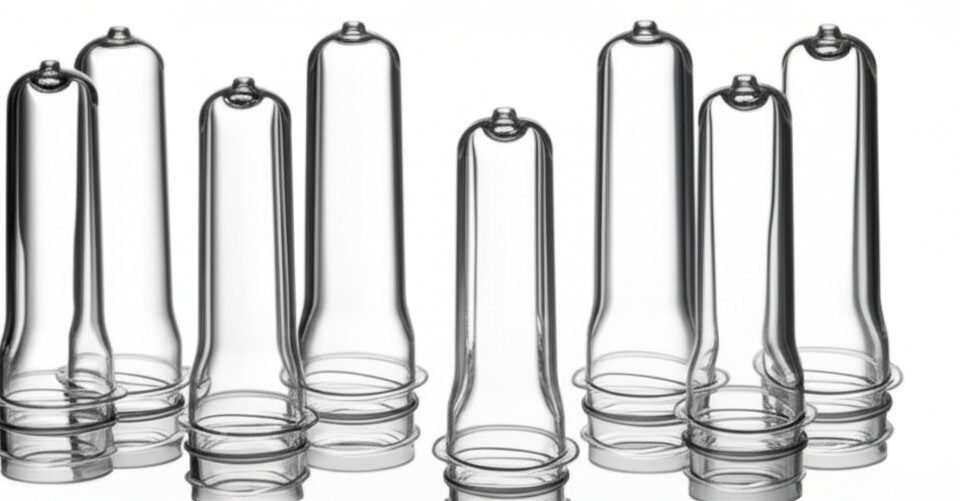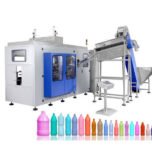When it comes to manufacturing plastic bottles, the focus often falls on design, weight, and clarity. But here’s the truth. PET preform neck type size can make or break your packaging line. Whether you’re dealing with beverages, edible oils, or pharmaceuticals, the PET preform neck size directly affects capping efficiency, leak resistance, and customer satisfaction.
And with the global PET preform market valued at USD 17.5 billion in 2025 and projected to reach USD 26.9 billion by 2035, which shows a CAGR of 4.4%, you have no choice but to get your PET preform neck types right.
Why PET Preform Neck Size Matters More Than You Think
The neck size is the top portion of a PET preform that holds the cap. It’s where the seal happens. If the cap doesn’t fit perfectly or the threads aren’t aligned properly, you’ll end up with leaks, loose caps, or worse, damaged product on the shelf.
From a technical standpoint, choosing the right PET preform neck type means aligning the neck dimensions with the intended cap, the liquid being filled, and the pressure the container needs to withstand.
A mistake here isn’t just a technical issue; it’s a profitability killer.
The Most Common Neck Size Standards Explained (28mm, 30/25, PCO, Alaska, etc.)
In India and globally, several standard types of PET preform neck size exist, each suited to a different product category. Let’s decode the most widely used neck types and when to use them.
Common PET Preform Neck Types:
- 28mm PCO (Plastic Closure Only): Commonly used for carbonated soft drinks due to its strength and pressure resistance.
- 30/25 Neck: Preferred for packaged water bottles and still beverages. Lighter, cost-effective.
- Alaska Neck PET Preform: A versatile design used in both water and oil bottles. Known for leak-proof performance.
- 38mm 3-Start: Larger diameter, used in juices and milk bottles for easy pouring.
- Short Neck (28mm SC or 1810/1881): Used to reduce resin weight and cost.
Each neck type differs in thread design, sealing performance, and cap compatibility. For instance, an Alaska neck PET preform supports a tamper-evident closure, making it ideal for edible oils and dairy packaging.
The problem? Many manufacturers assume all 28mm necks are the same, but thread profiles like 1810 and 1881 differ subtly—and critically.
Matching your cap, closure type, and filling method to the right PET preform neck type ensures optimal performance and customer safety.
Mistake #1: Using the Wrong Neck Size for the Product Type
Let’s say you’re packaging carbonated beverages and opt for a lightweight 30/25 PET preform neck because it’s cheaper. That’s a recipe for disaster. These preforms can’t handle the pressure of fizzy drinks, leading to burst bottles or leaky caps.
Similarly, using a 28mm Alaska neck PET preform for high-viscosity edible oils might work short term, but you may face drip issues, loose closures, or complaints from consumers struggling with messy pours.
Why This Happens:
- Buyers prioritise cost over compatibility.
- Miscommunication between the procurement and R&D teams.
- Suppliers pushing generic stock rather than customised fits.
Mistake #2: Ignoring Cap Compatibility During Preform Sourcing
This one’s all too common: A manufacturer buys PET preforms in bulk but doesn’t confirm if their existing caps fit those preforms. The result? Assembly line chaos.
What Goes Wrong:
- Capping machine jams or misalignments.
- Caps crack or pop off due to incorrect thread engagement.
- Tamper-evident bands don’t seal or break prematurely.
Alaska neck PET preforms, for example, are designed for specific tamper-proof caps. Trying to match them with generic 28mm closures? You’re asking for trouble.
Why It Happens:
- Procurement teams focus only on weight and cost.
- Suppliers assume the buyer understands cap-thread compatibility.
- No trial fit is done before bulk order confirmation.
Solution:
Before finalising any PET preform neck type, ask for:
- Cap compatibility specs.
- Test samples.
- Capping machine adjustment guides.
Always test preforms with your actual cap and machinery before mass production. It’s a small step that saves big.
Mistake #3: Switching Neck Sizes Without Recalibrating Machinery

Switching from a 28mm Alaska neck PET preform to a 30/25 may seem like a smart cost-saving move. But without recalibrating your blow moulding and capping machinery, you’re setting yourself up for rejection rates of 10–15% or more.
Risks Include:
- Improper bottle blowout.
- Seal failures on the line.
- Thread mismatches between cap and neck.
Blow moulding machines are fine-tuned to specific PET preform neck types. Even minor thread differences can throw off the entire production run.
How to Avoid It:
- Inform your production team before switching neck sizes.
- Get blow mould and capper specs updated.
- Run small test batches to ensure compatibility.
Manufacturers across India are increasingly using semi-automatic lines for PET bottle production, especially in Tier-2 cities. These setups need precise alignment—don’t let a neck switch derail your operation.
Mistake #4: Overlooking Neck Finish Tolerances
What’s a neck finish tolerance? Simply put, it’s how much variation is allowed in the diameter and thread dimensions of your PET preform neck. Even a 0.2mm deviation can cause major sealing issues at high speeds.
Real-World Impact:
- Poor seal strength.
- Tamper bands that don’t snap correctly.
- Bottles that wobble or don’t stack.
According to BIS standards (IS 14534:1998), neck tolerances must adhere to strict limits to ensure cap integrity and leak prevention. But many small-scale manufacturers overlook this completely.
Especially for Alaska neck PET preforms, tolerances must be tighter due to their unique sealing ring design. If the band doesn’t engage correctly, your bottle’s tamper evidence fails, which is a regulatory issue in India.
Fix: Always ask your supplier for a dimensional tolerance report. Check against your cap’s closure specifications. Precision here = fewer rejections later.
Mistake #5: Ordering One-Size-Fits-All Preforms Across Multiple SKUs
Manufacturers trying to simplify procurement often go with a “universal” preform across different product lines. On paper, it sounds smart. But when you use the same PET preform neck size for carbonated drinks, still water, and edible oil, things start falling apart.
What Could Go Wrong?
- A bottle meant for carbonated drinks may not seal properly with a still beverage cap.
- Caps could be too loose or too tight, leading to complaints or product leakage.
- Brand image suffers due to poor packaging consistency.
For example, Alaska neck PET preforms are great for still beverages and oils but may not perform well under pressure in carbonated applications.
The reality is—there’s no “one size fits all” when it comes to types of PET preform neck size. Each SKU may demand a different neck design based on:
- Viscosity of the liquid
- Required shelf life
- Filling speed and capping method
Solution:
Map your product SKUs to specific PET preform neck types. Don’t compromise for convenience—it ends up costing you more in the long run.
How to Read Neck Finish Specifications the Right Way
Neck finish specs often look like complicated engineering jargon, but understanding them can save you from costly mistakes.
Key Terms to Know:
- T Thread: The thread style for screw caps. Must match the cap profile.
- Start Angle: Where the thread begins. Crucial for cap engagement.
- Neck Ring: The small collar below the thread. Helps align the bottle in filling machines.
Let’s say your Alaska neck PET preform datasheet says:
Neck Type: Alaska / 28mm / 1810
Thread Start Angle: 120°
Neck Ring: 21mm
If your cap’s start angle is mismatched or your machine grabs the neck ring too high, it can lead to misaligned sealing, even if everything else looks right.
Pro Tip:
- Ask your supplier for a neck drawing with tolerance limits.
- Match it against your cap manufacturer’s specs.
- Don’t skip trial production—even if the numbers match.
Understanding these details ensures your PET preforms aren’t just visually compatible—they’re functionally perfect.
What Happens When You Ignore ISBM Compatibility
ISBM stands for Injection Stretch Blow Moulding—the process used to turn PET preforms into bottles. Each machine is calibrated for specific neck types, mould dimensions, and blowing parameters.
Ignoring ISBM compatibility can:
- Increase your scrap rate by up to 20%.
- Cause uneven wall thickness.
- Result in neck distortion, making the bottles unusable.
For example, if your ISBM line is set for 30/25 preforms but you suddenly switch to Alaska neck PET preforms, the stretch rod alignment may be off. That alone can wreck an entire shift’s production.
What to Do:
- Share your ISBM line’s neck ring and stretch rod specs with your supplier.
- Test a small run before placing a large order of different PET preform neck types.
- Keep your machine calibrations updated and documented.
The Financial Cost of Neck Size Errors (Spoiler: It’s Not Just the Bottle)
Think neck size mistakes only cost you a few rupees per preform? Think again.
- Rejected Preforms: ₹1.50–₹2 per unit wasted.
- Downtime: ₹5,000–₹20,000 per hour lost in production.
- Returns from Distributors: Up to ₹3 lakhs per rejected batch.
- Lost Trust/Brand Value: Priceless.
In India’s highly competitive bottled water and edible oil markets, packaging errors can quickly become expensive.
How to Choose the Right PET Preform Neck Size Every Time
Here’s a quick step-by-step guide to picking the right neck type without second-guessing yourself:
PET Preform Neck Selection Checklist:
- Identify the product (carbonated, still, oil, pharma, etc.)
- Select ideal neck type:
- Water ➝ 30/25 or Alaska
- Soda ➝ 28mm PCO
- Oil ➝ Alaska or 38mm
- Match with cap specs (thread type, tamper band, material)
- Review filling line capabilities (speed, capping torque, orientation)
- Check BIS guidelines for food-grade safety
- Conduct trial production run
- Document and verify machine calibration
Use this before every procurement round. It’s your safety net for avoiding expensive errors in selecting PET preform neck types.
Fixes for the Top 5 Neck Size Mistakes (Without Starting from Scratch)
Already in trouble with the wrong neck sizes? Don’t panic. Most issues can be fixed. Here’s how:
- Mismatch with Cap: Try sourcing caps that match the preform thread.
- Sealing Issues: Add liner inserts to improve closure performance.
- Machine Calibration Problem: Bring in a technician to adjust the capping head or stretch rod.
- Tolerance Trouble: Switch to a more precise supplier with BIS certifications.
- Wrong Neck for SKU: Reassign existing PET preforms to a different product line, if compatible.
For example, if your Alaska neck PET preform is underperforming for a fizzy drink, repurpose it for still water or cooking oil instead. A little creativity and technical adjustment can save you lakhs in replacement costs.
Final Thoughts: Don’t Let the Neck Be Your Bottleneck
In the grand scheme of bottle manufacturing, the PET preform neck size might seem like a small detail, but as we’ve seen, it’s one that can cause big problems if overlooked. From mismatched caps to machine downtime, the consequences of choosing the wrong PET preform neck types can ripple across your entire production line. Whether you’re dealing with Alaska neck PET preforms or standard 28mm finishes, the key is clear: know your product, understand your equipment, and communicate openly with your suppliers.
The good news? These mistakes are 100% preventable. With a bit of technical awareness and the right checklist in hand, you can avoid costly rejections, improve product integrity, and keep your operations running smoothly. Need a manufacturer who abides by all of this and more? Check us out.





